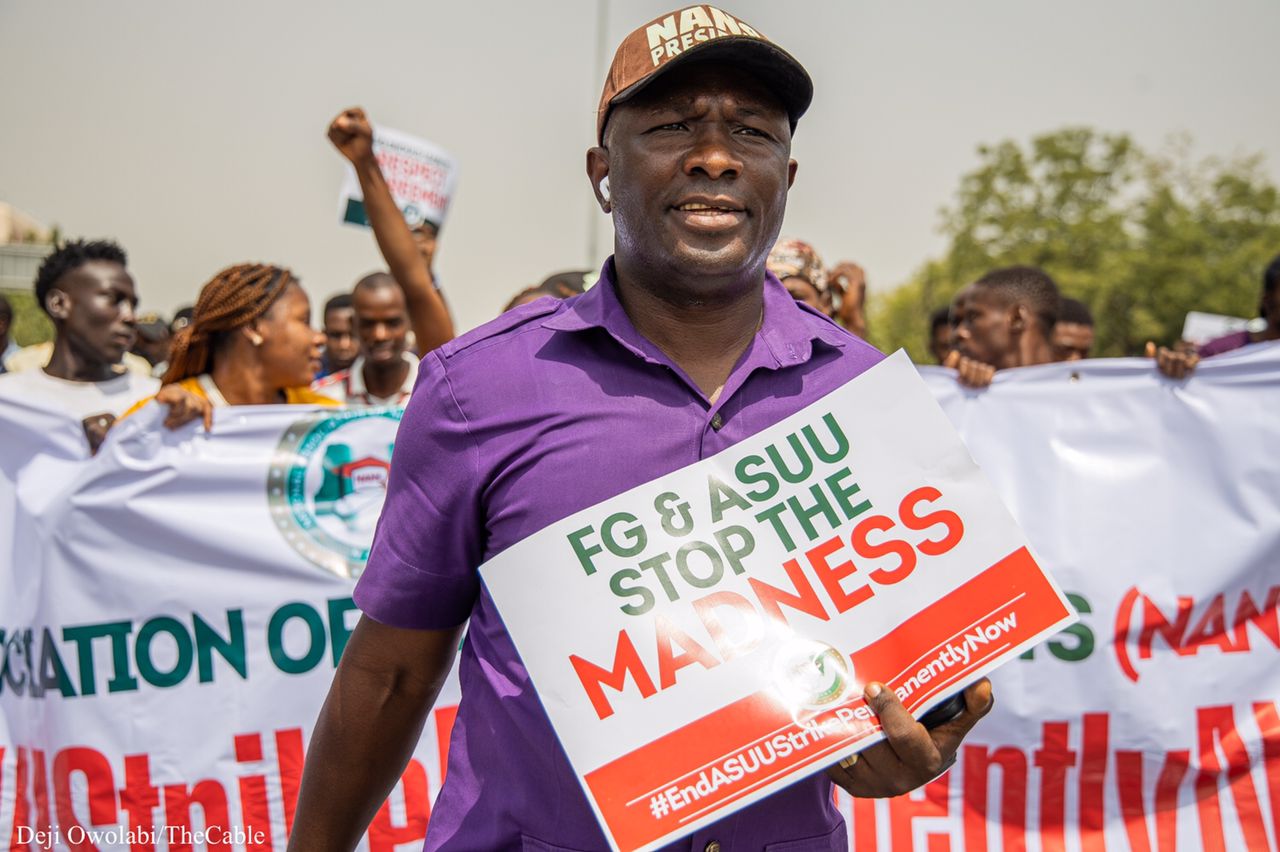The ongoing strike by the Academic Staff Union of Universities (ASUU) has now become the second longest-running strike by the same union since the return to democracy. It has shut down education in public universities across Nigeria for 200 days and counting as of September 1, 2022. The longest running strike stands at 270 days, which began in 2020. Since 1999, a 23-year period, there have been 16 ASUU strikes; including this one. ASUU has made its demands clear. There have been past negotiations as well as agreements based on those negotiations.
ASUU’s position now is that all demands must be met by the government, as the lack of implementation of previous agreements has put it in a position where it finds it hard to believe that the government will honour its agreements. The government’s position, of course, is that the demands ASUU is making, based on the previous agreements, do not take into account one fundamental issue – Nigeria is broke and doesn’t have the funds to meet its demands. At our firm, SBM Intelligence, we have a weekly debate where our researchers meet and discuss issues to sharpen analysis, broaden perspectives and also come up with solutions. We have an intern, an undergraduate who has been with us since the current ASUU strike began and as a student of one of the affected universities, he has made sure we discuss the issue as an agenda item weekly over the past couple of weeks. At this time, we have come up with a framework that this piece will present broadly. The major credit for much of the framework goes to our head of research, Ikemesit Effiong.
Both the Nigerian government and ASUU have consistently repeated the same things over the course of the last 23 years and even further back to when ASUU strikes became a thing in the 1980s. ASUU lists demands that typically include remuneration, funding for improvement of school infrastructure, privileges for senior lecturers/professors and exemptions for lecturers from general payment terms for public servants amongst others. On its part, the government would typically ignore or refuse to meet these demands, the strikes then commence and run until ASUU and the government negotiate a truce. Agreements are reached and then initially, parts of the agreements are met by the government but in the long term, it fails to continue to meet its obligations and then another round of strikes commence, repeating the cycle. In this, the students suffer.
When problems repeat in this cyclical nature, it usually means that the causes of problems are structural and that fixing them permanently requires radically altering the structure. It also almost always means that there is a fundamental misalignment of incentives that needs to be fixed before the solution can begin to have an effect. When we look at the standards of instruction, infrastructure and quality of students that graduate from public universities compared to private universities over the last 20 years, we can see clearly that private universities have emerged above public universities, and the gap continues to widen. The public universities have their incentives arranged such that they aspire to similar levels of uniform mediocrity, whereas the private universities have stratified such that the top schools are clear, and each school can price and attract student types according to where it stands in this stratification. We’ve also seen top employers begin to express a preference for graduates from specific private universities.
Advertisement
It is particularly curious because in many cases, it is the same teaching staff that lectures in the public and private universities – the difference is that they are incentivised in the private system to deliver value, whereas they are assured in the public universities that they will receive funding irrespective of if the students and their parents feel they have received value. The direct funding of public universities by the government in Nigeria has therefore created a perverse incentive that has resulted in this homogenous mediocrity earlier mentioned.
The fixation on producing university graduates has created a few imbalances that I believe are worth raising before we propose our solution. Wages in many businesses that demand that their vacancies require university graduates to fill are not commensurate with the number of years or real costs of producing a university graduate (if we factor in the government subsidy of university education using private university costs as a benchmark). The reality is that many of these roles do not require a university education to fill, and in many other countries – the equivalent of secondary school education will fill those roles effectively and then people either go on to get a university education after working for a while, or obtaining training in vocational skills, or rise based on the skills and performance on the jobs. I’ve reported to or worked with senior American, Asian or European professionals who did not go to college, and who when they decided they wanted to obtain Master’s degrees, their work experience counted towards entrance into the programmes. This was also the norm at some points in Nigeria’s history. But the combination of government subsidised university education where the performance of both the universities and the students are not a major consideration in who gets subsidised means university education is not about the knowledge and skills acquired there but as a signalling tool that the employers then use as a shorthand to hire.
Hence universities are no longer a place for the best of the best to acquire knowledge but a no-brainer next step after secondary school. And you cannot blame the people, since it is the best signalling to get what counts for a shot at decent employment. A misalignment of resources has fractured the education, employment and rewards systems in the job market. Ironically, this extends to the lecturers themselves. The level of pay they receive is not commensurate with the investment in time, cost and intellectual exertions that they have to make to obtain their qualifications because of this imbalance.
Advertisement
Another imbalance to highlight is the fact that a lot of the attention on ASUU and university education takes away focus from where the real issues are in Nigeria – the collapse of quality public basic education. According to the 2021 Multiple Indicator Cluster Survey carried out by the National Bureau of Statistics and published in August 2022, only 26.8% of children between ages seven and 14 in Nigeria could read functionally in any language and only 25.4% could carry out basic arithmetic. In spite of these alarming statistics, in a reversal of our reality and what global priorities even in developed countries are, instead of focusing public resources on public schools for basic education (primary and secondary schools), Nigeria has an obsession with tertiary education. Primary and secondary schools can be dead and substituted by private schools (which interestingly are cost and quality stratified – something universities have vehemently decided is an anomaly in Nigeria), just ensure that our universities and polytechnics continue to be funded by the government and are cheap even if they are mediocre and closed most of the time.
A third imbalance is the possibility that the action of one union can shut down university education nationally. Because they are all employees of one entity, the government, the union cuts across the universities and shuts them down at will. In reality, this type of universal failure point should not exist in a learning system. It means that a grievance in one university can effectively lead to a shutdown of universities nationwide.
What then is the fundamental structural issue under which attempts to permanently end ASUU strikes, and improve the quality of tertiary education as well as correct these and other imbalances will be futile? I have alluded to the answer in this piece. As long as the federal government and/or state governments continue to fund universities directly via subventions/allocations as if they are a parastatal of government, irrespective of their performance, we will continue to repeat this negative cycle. It is why we must not let the current crisis go to waste.
First, the government must reiterate that it intends to honour previous agreements with ASUU. Government is a continuum and when entities negotiate with the government and an agreement is reached, there must be confidence that the government, whether it’s the current administration they are negotiating with or a subsequent one, will honour such an agreement. It creates an atmosphere where negotiations are much easier and the costs of meeting the outcomes of the agreements can be spread over a longer period because the entities trust the government to meet its obligations. Our proposal requires the government to agree to a four-year phased implementation to ensure the whole thing falls within one administration and that the costs of meeting the financial implications of meeting these obligations can be spread over four budget cycles. This will either be moved to a first-line charge for that four-year period, without the option of extending it or into some warehouse structure managed by independent-minded agencies like the NSIA. The framework must be tight such that is impossible to legally extend this charge beyond the four years, otherwise, it will go the way of most temporary solutions in Nigeria that become a permanent drain on the government.
Advertisement
But this is not where it ends. The government is taking on this significant cost and making this watertight concession, only if ASUU agrees to key changes in the relationship of the federal government with the universities. The agreement must include a phased withdrawal of government subventions/funding to universities and the handover of each university to its senate in these phases. Each of the years, as the government meets the milestones set for that year in the agreement, 25% of the funding from the federal government stops going to universities as subventions, gradually increasing their autonomy. That way, by the end of the four-year period, the universities are 100% autonomous, and the government has a new pool of funds which can only be deployed for two purposes.
The first of these is to fund basic education. The detail of this basic education funding is something we have discussed in more detail in SBM. A key part we will mention here is in ensuring that the students that finish secondary school have the basic skills to do most jobs in the economy – reading, writing, numeracy, computing, history and vocational training. The second part of what the freed-up funding should go to will be highlighted here.
As autonomy develops, the schools will have no choice but to seek funding as their private counterparts do, or be culled. This will mean raising school fees as well as seeking funding from alumni, endowments, research patents sales and operating businesses. And schools will only be able to do this based on the value they give their present students/parents/communities, their alumni as well as the companies and economy as a whole. Stratification will occur and schools will no longer have uniform levels of mediocrity. Funds will then need to be put in a structure that will enable students to apply and obtain funding directly, tied to their national identity numbers (that’s a fundamental building block I mentioned in my first piece in this series, to be completed in the first year).
The criteria for accessing this funding must be open, merit-based and tied to the performance of the students. Lecturers can also apply for this funding for research and qualifying further. As with the students, this must be tied to performance on the job and their academic performance. This way, we ensure that the best enter and are retained at the highest levels of tertiary education, and create an incentive for the institutions and the students to perform better. Funds flow to performers. This funding is subject to availability and as the autonomy gets greater, meaning the universities get more expensive, more funds are available to the government to deploy towards this student scholarship/subsidy. This will enable students from underprivileged backgrounds to access tertiary education at whichever level in the university strata their performance supports.
Again, we have discussed the more granular details in SBM. Students who benefit, thus, will have their income levels monitored via their NIN, which doesn’t change and which their employers will be required to communicate to the government. Once they cross a specific income threshold, they will be required to pay a small portion of their income as a contribution to the pool of funds that will go into the basic education and tertiary education scholarship fund.
Advertisement
The ultimate goal of this will be to align the incentives in the education system to deliver positive outcomes that support national development in a sustainable manner, within our current realities. ASUU strikes can be a thing of the past if we do not waste this crisis.
Tunde Leye, author of the Afonja series, is a partner at SBM Intelligence
Advertisement
Views expressed by contributors are strictly personal and not of TheCable.
Add a comment







